Helping a Dancer with Foot Pain
 Today I helped a dancer with foot pain using Reembody Method. She had pain in the balls of her feet from dancing in heels. The pain was more intense in her left foot, which was her non-dominant (ND) side. As she described her situation, I was forming a picture in my mind about what her steps might look like, and how her ankles and feet moved.
Today I helped a dancer with foot pain using Reembody Method. She had pain in the balls of her feet from dancing in heels. The pain was more intense in her left foot, which was her non-dominant (ND) side. As she described her situation, I was forming a picture in my mind about what her steps might look like, and how her ankles and feet moved.
Frequently, dancers are instructed to push the back foot into the floor, almost like the foot is an oar in the ocean. This has the counter-intuitive result of stalling forward momentum, while dispersing unwanted force into the tiny bones in the balls of the feet.
We were working online[i]. I observed her walking. Then she lay on her back with pillows under her knees. She followed my instructions to plantar flex her left ND ankle. Plantar flexion looks like pointing the toes, but the action is isolated to the ankle joint while the toes remain completely relaxed. It can be surprisingly difficult to uncouple these movements.
I could see where she was having problems. To create the pointed shape, she was pushing her forefoot down as though pressing on a gas pedal, with minimal movement in the ankle. The action I was looking for requires sliding the heel bone along the floor towards the body by shortening the Achilles tendon. The Reembody method predicts that people will have a harder time organizing this movement on the non-dominant leg, which seemed to be the case. So, I had her switch legs, and try it on her right dominant leg.
Piece of cake.
Next, she practiced a sequence of upper and lower leg rotations on her right D leg that I thought she would need to improve the launching[ii]capability of her left ND leg. According to the Reembody Method, we tend to stop using our ND leg as an effective launcher, and the bones spiral in directions that make this leg trend towards bending and weak force production. It gets a bit soggy. Over time, the ND side grows dormant, and we end up doing almost all the work of locomotion and support on the D side of the body. You can observe this by watching people walk. Since most people are right legged, watch how people post over the left leg. Observe how the left leg tends to rotate out and doesn’t land under the center of mass.
Then I had her rest. Rest is an important part of learning new skills.
Then I asked her to visualize the movement sequence on her right leg, followed by visualizing the sequence on her left leg, followed by performing the movements on her left leg.
Piece of cake.
The two sides the body learn from each other, due to the chiastic nature of the nervous system – stay tuned, that’s another blog.
Next, she stood up and commented that the left leg felt longer, more stable and easier. I could see that she was allowing it to bear more of her body weight.
Then we translated the actions of the leg on the floor to the way the leg moved during gait. I had her position the left leg behind in the “pushing off phase” (but please don’t push off the foot, remember we don’t have oars). As she drew her heel bone up away from the floor and shortened her Achilles tendon, she allowed her shin, thigh and pelvic bones to spiral as we had practices. “I feel less pressure in the ball of my foot.”
Bingo!
True, she’s got a bit of homework to integrate this new way of moving into dancing in heels, but the beauty of Reembody Method is that newly learned movement sequences are “sticky,” meaning, the body adopts them quickly and unconsciously. This is surprising and different from most training models. Usually repetition, reward and effort are needed to build a new habit. We think, but don’t know for sure, that Reembody works more quickly because the movement sequences provide the central nervous system (CNS) with an immediate feeling of safety, hence we gravitate towards the new movement. It’s only under heightened stress, that we are likely to revert to the old inefficient patterns and will need to again practice the optimal joint rotations.
This is a small example of how the Reembody method can be used to solve pain, and fine-tune our movement for better living, sports performance and artistic expression.
I’m teaching an introductory class at Berkeley Rep starting July 10, where as a bonus you will also learn methods from the Alexander Technique.
Join me!
[i]Many Alexander Teachers do teach online but it is still quite controversial in our community. It takes many years of training to get the special quality of directive touch that marks an AT teacher’s hands. That touch is an art from, and many feel that without it, the technique loses its integrity and heart. I remain neutral on the topic, but for now chose to teach Alexander Technique in person, and use an online platform for other forms of mindful movement training.
[ii]Launching is the moment the back foot leaves the ground and springs forward. In the arms, you might think of it as expressing or releasing force, for example the moment an arm explodes forward in a punch or to throw a ball (to be discussed in a future blog).










